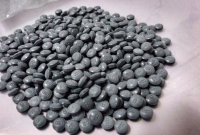Support strong Canadian climate journalism for 2025
Nova Scotians will have wide−spread access to the antidote for opioid overdoses as part of the provincial plan to address the drug problem that continues to grow across the country.
Free naloxone kits will be available at over 300 community pharmacies beginning Sept. 1, provincial Health Minister Randy Delorey said Wednesday.
"By putting naloxone in pharmacies, we want to make it accessible to everyone in a convenient and trusted location — one that doesn’t carry a stigma if you are to go in to visit," said Delorey.
The move to expand the $564,000 antidote program originally announced in March, was presented as part of a new plan released in Halifax to address opioid use and overdoses.
The framework focuses on five key issues, including understanding the issue, prevention, harm reduction, treatment, prescribing practices and law enforcement.
"We may not be seeing the opioid use and overdose at the same levels here in Nova Scotia as we are seeing in other parts of Canada, but we do know the issue is growing and it is moving east," said Delorey. "We are committed to doing what we can to address this serious issue."
According to provincial figures, there were 54 acute opioid overdose deaths in the province in 2016, with four involving illicit fentanyl and three others involving another powerful synthetic opioid, U−47700. Another 24 confirmed deaths and five probable deaths from opioid toxicity have been recorded so far this year.
Canada’s chief public health officer has said that if current abuse trends continue, the national death toll could top 3,000 this year. Nova Scotia officials said deaths linked to opioid overdoses will be posted online as part of a wider public education effort.
There are also plans to share more specific information around drug seizures between police forces and other first responders, although it’s unknown at this point whether any of that information will be made public.
"What we are looking for is whether there is a particular hotspot in Nova Scotia where a certain type of drug, say fentanyl or carfentanil, may be showing up," said Roger Merrick, the province’s director of public safety.
"By identifying these particular hotspots, we will be able to notify our stakeholders in health of the potential for harm that may come in particular geographic areas."
Merrick said the province’s corrections system is also exploring the possibility of purchasing body scanners like those found in airports to detect drugs in jail settings, although he later noted that at $200,000 a piece for the machines the cost might be found to be prohibitive.
Chief medical officer of health, Dr. Robert Strang, said two other significant measures — safe injection sites and prescription standards for addictive painkillers — were still being studied.
Strang said the use of safe injection sites are more complex, despite the fact many have already been implemented in other Canadian jurisdictions.
"We are not jumping to the conclusion that is what is necessary or appropriate here in Nova Scotia," he said. "We are doing the work to explore what, under the broad umbrella of safer consumption, is actually necessary."
The expansion of the naloxone program is part of an overall $1.1−million funding initiative announced in March that also distributed kits to police, provincial jails and harm reduction clinics in Sydney, Truro and Halifax.
As well, funding support was provided to community−based organizations that distribute needles and information to addicts.




Comments